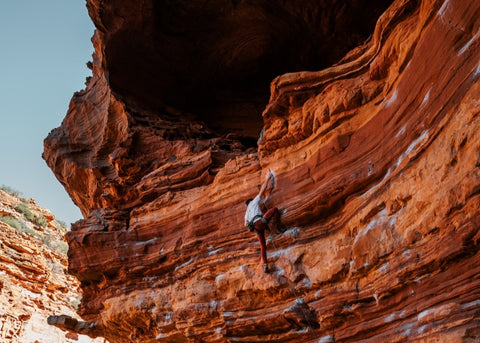
For outdoor rock climbers and boulderers, chalk is essential to help improve grip and reduce sweat.
But did you know that by using coloured climbing chalk, you can also help to protect the environment? Let’s take a look at why coloured climbing chalk is better for the environment than traditional white chalk.
The Benefits of Coloured Climbing Chalk
Using coloured chalk that matches the colour of the rock can avoid leaving behind unseemly white marks, also known as chalk graffiti. This is especially important if the area you are climbing in has cultural significance to the indigenous population, for example - Gariwerd (The Grampians) in Australia.
Aside from using coloured chalk, the only other ways to avoid leaving behind chalk graffiti is to either not use any chalk at all, or brush off the chalk marks. For those lucky climbers that don’t sweat much, not using chalk is a possible option. Brushing off is usually the least preferred option as it requires time, energy and gear set up to go back over the climb and brush off the white chalk marks, hold by hold.
If many climbers use coloured chalk, over time we can also cover up existing white chalk marks left by previous climbers.
Which Coloured Climbing Chalk Matches Where?
- Gariwerd (The Grampians), Victoria, Australia - Australian Sandstone and Limestone Grey
- Djurite (Arapiles), Victoria, Australia - Australian Sandstone
- Werribee Gorge, Victoria, Australia - Australian Sandstone and Limestone Grey
- The You Yangs, Victoria, Australia - Limestone Grey
Is Coloured Climbing Chalk Bad For The Environment In Any Way?
Most climbing chalks will not be harmful for the environment as long as they utilise mineral pigments and don't use dyes. Colouring such as dyed magnesium oxide (MgO) can leach into the rock.
Redpoint Climbing’s coloured chalk is formulated with natural mineral pigments and high purity magnesium carbonate, sustainably sourced from seawater. Our chalk does not contain dyes.
Will Coloured Climbing Chalk Stain My Hand?
No, coloured climbing chalk will not stain your hand as it does not contain dyes.
When it comes to preserving the environment, it’s not just about what we don’t do - it’s also about what we do. Switching from traditional white chalk to colored climbing chalk is one small act that can have a big impact over time. It also minimises the need for frequent brushing of holds, which can save time and energy in the long run.
So next time you go outdoor bouldering or rock climbing, why not give coloured climbing chalk a try? It just might be the best decision you make all season!
